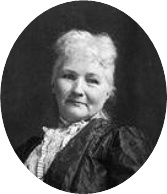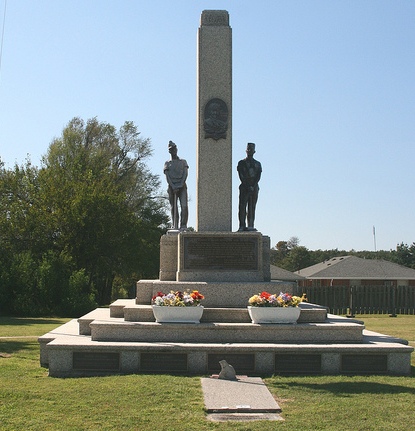|
Mary Harris "Mother" Jones
(1837 - 1930)
Labor Activist and Organizer, Speaker, Teacher
Mary Harris Jones, an unremarkable Irish
emigrant to America in the early 1840s, nonetheless
went on to leave her footprint in the
history of the American labor movement and, also in
the history of the Irish-American diaspora.
She was once described
as the most dangerous woman in America by a member of the economic
elite for her advocacy of economic justice for the working class.
She was also mocked as the "grandmother of all agitators" on the floor of
the U.S. Senate, a characterization she wholeheartedly agree with.
She helped shape a spirit of
disobedience in the cause of justice, the type of disobedience that
the late U.S. congressman, John Lewis would refer to as "good
trouble". She was, and still is, a role model for women crusaders
for social justice, gender equality, femicide and a slew of other
injustices levied at women around the world.
--------------------------------------------------------------------------------------------------------------------------
 Mary
Harris was born on May 1, 1837 in Inchigeelagh, Co. Cork, Ireland
to tenant farmer
Richard Harris and his wife Ellen Cotter. It is believed that
Mary had three siblings although there is scant evidence to support
the existence of any siblings. Many accounts have her born in 1830,
however, 1837 as the year of her birth is supported by documented
evidence including that of her baptism in 1837 and her graduation
from in high school in 1854. Mary
Harris was born on May 1, 1837 in Inchigeelagh, Co. Cork, Ireland
to tenant farmer
Richard Harris and his wife Ellen Cotter. It is believed that
Mary had three siblings although there is scant evidence to support
the existence of any siblings. Many accounts have her born in 1830,
however, 1837 as the year of her birth is supported by documented
evidence including that of her baptism in 1837 and her graduation
from in high school in 1854.
The Harris family
had a long history of resistance to the
British occupation of Ireland. Mary's paternal grandfather
was hanged by the British for his opposition to their oppressive
rule. It is likely that during the Tithe War of 1830 to 1836, when
Irish tenant farmers were taxed to support the Anglican church in
Ireland that he became a victim of British retribution for
physically opposing such an unjust and oppressive levy.
When Mary was five years old her
father emigrated to the United States to avoid the same fate meted
out to his father. After he found employment, housing and
sufficient funds he sent for his family. His job as a construction
worker took him to Toronto where Mary spent her childhood years.
Mary attended public schools in
Toronto. She was studious and ambitious and graduated from high
school in 1854 with high honors. The next year, she began working as
a private tutor in Maine. From there she moved to Michigan where she
received a teaching certificate. After becoming a certified teacher
she taught at St. Mary's Convent school in Monroe, Michigan. Her
next move was to Chicago where she took up dressmaking.
Her dressmaking career in Chicago
did not last too long for in 1861 she moved to Memphis to resume her
teaching career. It was there that she met and married George E.
Jones, an iron molder who was a member of the Iron Molders' Union.
The next four years were probably the happiest in Mary's long life.
She and George had four children. As work was plentiful in Tennessee
they were reasonably well off not wanting for the basic needs to
raise a family. However, in 1867 a sudden yellow fever epidemic
swept through Memphis, taking the lives of Mary's husband and her
four children. At 37, the happiest years of Marys' came to an end
leaving her devastated and completely on her own.
Unable to stay in Memphis after the
loss of her family Mary returned to Chicago where she established a
dressmaking business. Bad luck continued to haunt her for in 1871
the Great Fire of Chicago destroyed her home and business leaving
her homeless and penniless. Alone and desperate she turned to her
deceased husband's fellow union members for help. The kindness
extended to her by the union workers was in stark contrast to the
indifference shown by her wealthy employers for the wretched
homeless and poor souls who aimlessly wandered the streets in search
of employment or food to feed their families.
In her biography she expressed her
revulsion to such wanton indifference when recalling earlier
experiences. "Often while sewing for the lords and barons who
lived in magnificent houses on the Lake Shore Drive, I would look
out of the plate glass windows and see the poor, shivering wretches,
jobless and hungry, walking alongside the frozen lake front. The
contrast of their condition with that of the tropical comfort of the
people for whom I sewed was painful to me.” My employers seemed
neither to notice nor to care".
The compassion of the exploited in
contrast to the callousness and indifference of the exploiters
galvanized Marys' resolve to dedicate the rest of her life to the
pursuit of a better life and working conditions for the ordinary
working man, woman and child.
For the next number of years Mary
made Chicago her base as she traveled from industrial area to
industrial area working as a union activist with the Knights of
Labor whose purpose was "to unite all workers under a single
organization". She had a real talent for inspiring others with
her speeches. During critical periods in labor strikes she would
convince workers to stay the course when the management brought in
strike-breakers and militias.
In 1873, during a coal miners’
strike in Pennsylvania she came face to face with Irish coal miners
many of whom were veterans of the Civil War. The conditions she
witnessed bordered on slavery with women and children near
starvation. It was her efforts on their behalf coupled with her
concern for their welfare that earned her the nickname "Mother
Jones."
Mary continued to travel the country
in support of striking workers. In 1877 she was involved in the
nationwide walkout for better conditions by railroad workers. In
1880 she was in Chicago on behalf of workers trying to obtain an
eight-hour day. She also took part in the strike at the
McCormick-Harvester works, where a bomb killed several policemen.
The police retaliated by firing randomly into a crowd of union
workers, killing 11 and wounding dozens of others.
Apart from her involvement as an
organizer and educator in striker tactics she gained prominence for
organizing the wives and children of striking workers in
demonstrations on their behalf. She became known as "the most
dangerous woman in America," a phrase coined by a West Virginia
district attorney, Reese Blizzard, in 1902, at her trial for
ignoring an injunction banning meetings by striking miners.
According to Clarence Darrow, she was "one of the most forceful
and picturesque figures of the American labor movement".
One of her best-known activities was
leading a march of miners' wives "who routed strikebreakers with
brooms and mops in the Pennsylvania coalfields in 1902.".
Another was leading the "children's crusade," a caravan of
striking children from the textile mills of Kensington,
Pennsylvania, to President Theodore Roosevelt's home in Long Island,
New York, in 1903, to dramatize the case for abolishing child labor.
In her later years she was arrested
during a violent strike in West Virginia and sentenced to 20 years
in jail. Public outcry was so loud that she was pardoned by the
governor and released. In 1913 she participated in the yearlong
strike by miners in Colorado. She was arrested and imprisoned twice
for a total of three months for trespassing on the mine owners’
property. After the "machine-gun massacre" of miners and their
families in a tent colony at Ludlow, Colorado, on April 20, 1914,
when 20 people were killed, she traveled the country informing the
public as to what happened. As a result of her efforts the
government of Woodrow Wilson was forced to intervene, forcing the
union and the owners to agree to a truce and create a grievance
committee at each mine.
Mary went on to participate in 1915
and 1916 in the strikes of garment workers and streetcar workers in
New York, and in the strike of steel workers in Pittsburgh in 1919.
In January 1921 she traveled to Mexico as a guest of the Mexican
government to attend the Pan-American Federation of Labor meeting.
According to one writer, "It was the high point of recognition in
her role in the labor movement."
Mary Harris "Mother" Jones died in
Silver Spring on November 30, 1930. She is buried in the Union
Miners Cemetery at Mount Olive, Illinois, in the coalfields of
southern Illinois. Her grave is near those of the victims of the
Virden, Illinois, mine riot of 1898.
Contributed by Tomás
Ó Coısdealbha.
cemetery AND grave location
Name:
Union Miners Cemetery PHONE
NO. (217)
999-4261
ADDRESS:
North Lake
Street, Mount Olive, IL 62069
MONUMENT

|